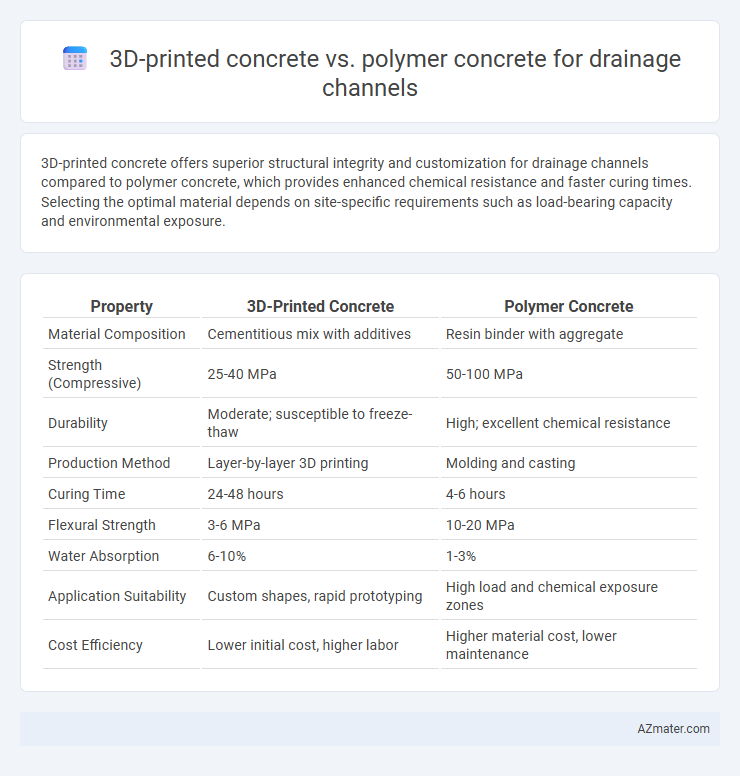3D-printed concrete offers superior structural integrity and customization for drainage channels compared to polymer concrete, which provides enhanced chemical resistance and faster curing times. Selecting the optimal material depends on site-specific requirements such as load-bearing capacity and environmental exposure.
Table of Comparison
| Property | 3D-Printed Concrete | Polymer Concrete |
|---|---|---|
| Material Composition | Cementitious mix with additives | Resin binder with aggregate |
| Strength (Compressive) | 25-40 MPa | 50-100 MPa |
| Durability | Moderate; susceptible to freeze-thaw | High; excellent chemical resistance |
| Production Method | Layer-by-layer 3D printing | Molding and casting |
| Curing Time | 24-48 hours | 4-6 hours |
| Flexural Strength | 3-6 MPa | 10-20 MPa |
| Water Absorption | 6-10% | 1-3% |
| Application Suitability | Custom shapes, rapid prototyping | High load and chemical exposure zones |
| Cost Efficiency | Lower initial cost, higher labor | Higher material cost, lower maintenance |
Introduction to 3D-Printed Concrete and Polymer Concrete
3D-printed concrete utilizes additive manufacturing technology to create customized drainage channels with enhanced design flexibility and reduced material waste. Polymer concrete, composed of resin binders and aggregates, offers superior chemical resistance and rapid curing, making it suitable for aggressive drainage environments. Both materials present innovative solutions, with 3D-printed concrete excelling in complex shapes and polymer concrete in durability against corrosive elements.
Material Composition and Properties Comparison
3D-printed concrete for drainage channels primarily consists of cement, aggregates, water, and additives tailored for extrusion and rapid setting, offering high compressive strength and durability with customizable layer-by-layer construction. Polymer concrete incorporates polymer resins as binders combined with aggregates, providing superior chemical resistance, reduced permeability, and enhanced tensile strength compared to traditional concrete. The material composition of 3D-printed concrete enables scalable and complex geometries, while polymer concrete excels in resisting aggressive environmental conditions, making each suitable for specific drainage channel applications based on performance requirements.
Manufacturing Processes: 3D Printing vs Polymer Casting
3D-printed concrete for drainage channels uses additive manufacturing technology, layering cementitious materials to create complex shapes with minimal waste and enhanced design flexibility. Polymer concrete involves casting a mixture of polymer resins and aggregates in molds, allowing controlled curing times and high chemical resistance. Compared to polymer casting, 3D printing enables rapid prototyping and customization but may require advanced equipment and material formulations to ensure structural integrity in drainage applications.
Structural Strength and Durability Analysis
3D-printed concrete offers enhanced structural strength due to its precise layer deposition, resulting in reduced weak points and uniform material distribution compared to polymer concrete. Polymer concrete exhibits superior chemical resistance and durability in aggressive environments, making it ideal for drainage channels exposed to corrosive substances. Analyzing both materials reveals that 3D-printed concrete excels in load-bearing capacity, while polymer concrete provides prolonged service life under chemical and abrasion stress.
Installation Efficiency and Flexibility
3D-printed concrete offers superior installation efficiency for drainage channels by enabling rapid, on-site customization and reducing labor costs through automated layering processes. Polymer concrete, while durable and resistant to chemical corrosion, requires prefabrication and longer curing times, limiting adaptability during installation. The flexibility of 3D-printed concrete allows for complex geometries and adjustments in real-time, outperforming polymer concrete's fixed mold constraints in tailored drainage solutions.
Performance in Harsh Drainage Environments
3D-printed concrete offers superior durability and flexibility in harsh drainage environments due to its layered construction and enhanced material composition, allowing for precise customization and improved resistance to chemical erosion and freeze-thaw cycles. Polymer concrete, composed of resin binders and aggregates, excels in chemical resistance and impermeability but may lack the mechanical adaptability and repairability afforded by 3D-printed concrete technologies. In environments exposed to aggressive chemicals, fluctuating temperatures, and heavy mechanical loads, 3D-printed concrete channels demonstrate enhanced longevity and structural integrity compared to traditional polymer concrete alternatives.
Cost Analysis: Initial and Lifecycle Considerations
3D-printed concrete for drainage channels offers reduced initial labor costs due to automation and material efficiency, whereas polymer concrete involves higher upfront expenses from specialized resin and additives. Lifecycle analysis reveals 3D-printed concrete provides enhanced durability and lower maintenance costs over time, benefitting long-term budget planning. Polymer concrete's chemical resistance can reduce repair frequency in aggressive environments, potentially offsetting its higher initial price in specific drainage applications.
Environmental Impact and Sustainability
3D-printed concrete for drainage channels reduces material waste and energy consumption by enabling precise layering and on-demand production, lowering the carbon footprint compared to traditional methods. Polymer concrete offers high durability and chemical resistance, extending service life and reducing maintenance frequency, which supports sustainability through resource conservation. However, 3D-printed concrete often utilizes more eco-friendly cementitious materials, while polymer concrete relies on synthetic resins that may pose environmental challenges in disposal and recycling.
Maintenance and Long-Term Reliability
3D-printed concrete drainage channels offer enhanced durability with minimal maintenance due to their homogeneous structure and reduced porosity, which limits water infiltration and crack propagation. Polymer concrete, known for its chemical resistance and high tensile strength, provides excellent long-term performance in chemically aggressive environments but may require specialized repair techniques if damaged. Both materials significantly outperform traditional concrete in longevity, with 3D-printed concrete excelling in structural integrity and polymer concrete offering superior resistance to environmental degradation.
Application Suitability for Modern Drainage Systems
3D-printed concrete offers high customization and rapid construction for complex drainage channels, making it ideal for modern urban infrastructure requiring tailored designs and quick deployment. Polymer concrete provides superior chemical resistance and durability against aggressive wastewater environments, ensuring long-term performance in industrial and municipal drainage systems. Selecting between these materials depends on specific project demands, balancing structural complexity with resistance to corrosive substances.

Infographic: 3D-printed concrete vs Polymer concrete for Drainage channel
 azmater.com
azmater.com